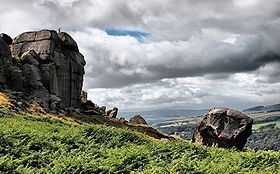OS grid SE114452 Elevation 402 m Listing Marilyn | Topo map OS Landranger 104 Prominence 244 m | |
 | ||
Similar White Wells, Swastika Stone, Manor House Museum, Ilkley Toy Museum, Salts Mill | ||
On ilkla mooar baht at on ilkley moor baht at the song and history
Ilkley Moor is part of Rombalds Moor, the moorland between Ilkley and Keighley (pronounced Keethly) in West Yorkshire, England. The moor, which rises to 402 m (1,319 ft) above sea level, is well known as the inspiration for the Yorkshire "county anthem" On Ilkla Moor Baht 'at (dialect for 'on Ilkley Moor without a hat').
Contents
- On ilkla mooar baht at on ilkley moor baht at the song and history
- Map of Rombalds Moor Ilkley UK
- Ilkley westwood lodge ilkley moor luxury self catering cottages take the tour
- Geology
- History
- Swastika Stone and other antiquities
- The Ilkley Moor Alien sighting
- Conservation
- Grouse shooting controversy
- References
Map of Rombald's Moor, Ilkley, UK
Ilkley westwood lodge ilkley moor luxury self catering cottages take the tour
Geology
During the Carboniferous period (325 million years ago), Ilkley Moor was part of a sea level swampy area fed by meandering river channels coming from the north. The layers in the eroded bank faces of stream gullies in the area represent sea levels with various tides depositing different sorts of sediment. Over a long period of time the sediments were cemented and compacted into hard rock layers. Geological forces lifted and tilted the strata a little towards the south-east, producing many small fractures, or faults. Since the end of the Carboniferous time there has been erosion and more than a thousand metres of the coal-bearing rocks have been completely removed from the area. During the last million years, Ice Age glaciers modified the shape of the Wharfe valley, deepening it, smoothing it and leaving behind glacial debris. The millstone grit not only gives character to the town of Ilkley but gives the area its acid soils, heather moors, soft water and rocky scars.
History
To the north, where the moor drops steeply towards the village of Ben Rhydding, a satellite of the town of Ilkley, are two millstone grit rock climbing areas: Rocky Valley and Ilkley Quarry.
Ilkley Quarry is the site of the famous "Cow and Calf", a large rock formation consisting of an outcrop and boulder, also known as Hangingstone Rocks. The rocks are made of millstone grit, a variety of sandstone, and are so named because one is large, with the smaller one sitting close to it, like a cow and calf. Legend has it that there was once also a "bull", but that was quarried for stone during the spa town boom that Ilkley was part of in the 19th century. However, none of the local historians have provided any evidence of the Bull's existence.
According to legend, the Calf was split from the Cow when the giant Rombald was fleeing an enemy, and stamped on the rock as he leapt across the valley. The enemy, it is said, was his angry wife. She dropped the stones held in her skirt to form the local rock formation The Skirtful of Stones.
In July 2006 a major fire on the moor left between a quarter and half of it destroyed.
Swastika Stone and other antiquities
Located on the Woodhouse Crag, on the Northern edge of Ilkley Moor there is a swastika-shaped pattern engraved in a stone, known as the Swastika Stone, also referred to as a Fylfot. The image at the bottom-right of the picture is a 20th-century replica; the original carving can be seen at the bottom-left.
This stone is just one of a great abundance of carved rocks on the moor, well known others include the 'Badger Stone', 'Nebstone' and 'St. Margaret's Stones'. These are earthfast boulders, large flat slabs or prominent rocks that have cups, rings and grooves cut into them and thought to date from either the late Neolithic or the Bronze Age. While some carvings consist of simple cups, others such as the Badger Stone, Hanging Stones and the Panorama Rocks have complex series of patterns (or motifs) combining many different elements. Indeed, Rombald's Moor can boast the second highest concentration of ancient carved stones in Europe, with carving as far away as Skipton Moor. There is also a small stone circle known as The Twelve Apostles.
"The Ilkley Moor Alien" sighting
On 1 December 1987, Phillip Spencer, a retired policeman saw and photographed what he believed was an alien being on the Moor. He said he saw the strange creature rush up the hill and give a signal to him with one of its arms as if telling him not to approach. He later saw a dome-topped craft at the top of the hill after following the being which shot into the air at a blinding speed. The Daily Telegraph included this event in a 2011 list of "Top 10 UFO incidents in the UK".
Conservation
The moor forms part of the South Pennine Moors Site of Special Scientific Interest (SSSI). It also forms part of the South Pennine Moors Special Protection Area (SPA) and Special Area of Conservation (SAC).
Grouse shooting controversy
In 2008 Bradford Metropolitan District Council let out the grouse shooting rights for Ilkley Moor. This move has led to controversy on the basis of its alleged impact on wildlife, walking, leisure and local tourism.
